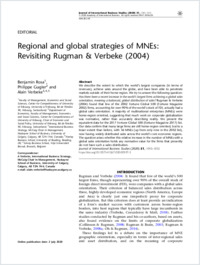Regional and Global Strategies of MNEs : Revisiting Rugman & Verbeke (2004)
- Rosa, Benjamin University of Fribourg
- Gugler, Philippe University of Fribourg
- Verbeke, Alain University of Calgary
-
2020
Published in:
- Journal of International Business Studies. - Academy of International Business. - 2020, vol. 51, p. 1045-1053
English
We describe the extent to which the world’s largest companies (in terms of revenues), achieve sales around the globe, and have been able to penetrate markets outside of their home region. We try to answer the following question: Has there been a recent increase in the world’s largest firms achieving a global sales orientation, meaning a balanced, global distribution of sales? Rugman & Verbeke (2004) found that few of the 2002 Fortune Global 500 (Fortune Magazine 2002) firms, accounting for over 90% of the world’s stock of FDI, actually had a global sales orientation. A majority of multinational enterprises (MNEs) were home-region oriented, suggesting that much work on corporate globalization was normative, rather than accurately describing reality. We present the equivalent data for the 2017 Fortune Global 500 (Fortune Magazine 2017) list. Our data confirm that many large firms are still home-region oriented, but to a lesser extent than before, with 36 MNEs (up from only nine in the 2002 list), now having widely distributed sales across the world’s core economic regions. The question arises whether this relative increase in the number of MNEs with a global sales orientation holds any normative value for the firms that presently do not have such a sales distribution.
- Faculty
- Faculté des sciences économiques et sociales et du management
- Department
- Département d'économie politique
- Language
-
- English
- Classification
- Economics
- License
-
License undefined
- Identifiers
-
- RERO DOC 333234
- DOI 10.1057/s41267-020-00347-5
- Persistent URL
- https://folia.unifr.ch/unifr/documents/309535
Statistics
Document views: 174
File downloads:
- Document: 250
